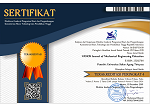Optimal Design of Gorlov Turbine Using Computational Fluid Dynamics and Taguchi Method
Abstract
Wind energy for electricity generation presents a promising alternative to fossil fuels, driving the development of renewable energy technologies. Computational Fluid Dynamics (CFD) stands out as a powerful tool in this domain. This study focuses on optimizing the design of Gorlov turbines through a combination of CFD simulations and the Taguchi method. The research identifies four key factors influencing turbine performance: twist angle, chord length, number of blades, and aspect ratio. These factors are systematically varied using an orthogonal array, resulting in nine distinct blade configurations. Subsequently, simulations are conducted using ANSYS Fluent software under transient conditions at a wind speed of 5 m/s. Simulation results reveal that the maximum angular velocity achieved is 29.8187 deg/s, accompanied by a torque of 0.426 Nm, leading to a calculated maximum power output of 12.73 Watts. Furthermore, Taguchi analysis and ANOVA are employed to assess the significance of each factor. The analysis highlights the aspect ratio as the most influential factor, accounting for 99.7% of the observed variation. This study underscores the potential of CFD and the Taguchi method in optimizing wind turbine design for enhanced performance. The findings emphasize the critical role of the aspect ratio in determining turbine efficiency, paving the way for more efficient renewable energy generation.
Keywords
Full Text:
PDFReferences
Retno Aita Diantari, “Sosialisasi Energi Baru Terbarukan dan Lingkungan Hidup Untuk Masyarakat Desa Sukawali Kab. Tangerang, Banten,” Jurnal Pengabdian Pada Masyarakat Menerangi Negeri, vol. 2, no. 1, pp. 53–59, 2019, [Online]. Available: https://stt-pln.e-journal.id/terang/article/view/538
P. A. Owusu and S. Asumadu-Sarkodie, “A review of renewable energy sources, sustainability issues and climate change mitigation,” Cogent Eng, vol. 3, no. 1, Dec. 2016, doi: 10.1080/23311916.2016.1167990.
Admin SMP, “Menilik Sumber Energi Terbarukan di Masa Depan,” Direktorat Sekolah Menengah Pertama. [Online]. Available: http://webcache.googleusercontent.com/search?q=cache:4XFzzMzeLSwJ:ditsmp.kemdikbud.go.id/menilik-sumber-energi-terbarukan-di-masa-depan/+&cd=2&hl=id&ct=clnk&gl=id
M. N.S., G. N.A., and A. G.A., “Role of Renewable Energy Sources in the World,” Journal of Renewable Energy, Electrical, and Computer Engineering, vol. 2, no. 2, pp. 63–67, Sep. 2022, doi: 10.29103/JREECE.V2I2.8779.
“Renewable Energy Definition - Sources, Clean Alternatives.” Accessed: Mar. 03, 2024. [Online]. Available: https://www.nrdc.org/stories/renewable-energy-clean-facts#sec-whatis
Abubakar Lubis, “Energi terbarukan Dalam Pembangunan Berkelanjutan,” Jurnal Teknik Lingkungan, vol. 8, no. 2, pp. 155–162, 2007, [Online]. Available: https://webcache.googleusercontent.com/search?q=cache:lhVluhJcKEoJ:https://media.neliti.com/media/publications/151118-ID-energi-terbarukan-dalam-pembangunan-berk.pdf+&cd=1&hl=id&ct=clnk&gl=id
F. Kurniawan, A. Samsudin, E. Sriwati, and B. Coştu, “The potential of renewable energy sources in Java Island: a systematic literature review,” Journal of Innovation Materials, Energy, and Sustainable Engineering, vol. 1, no. 1, pp. 50–69, Jul. 2023, doi: 10.61511/JIMESE.V1I1.2023.101.
“IOP Conference Series: Earth and Environmental Science”, doi: 10.1088/1755-1315/940/1/012032.
Dwi Hadya Jayani, “Berapa Potensi Energi Terbarukan di Indonesia?,” Kementrian ESDM. [Online]. Available: https://databoks.katadata.co.id/datapublish/2021/03/09/berapa-potensi-energi-terbarukan-di-indonesia
A. Haslinah et al., “Green technology’s function in the production of renewable energy and mineral extraction,” Caspian Journal of Environmental Sciences, vol. 22, no. 1, pp. 93–102, doi: 10.22124/CJES.2023.6759.
Didik Notosudjono, “Perkembangan Teknologi Energi Terbarukan di Indonesia,” Jurnal Riptek, vol. 13, no. 2, pp. 177–186, 2006, [Online]. Available: https://webcache.googleusercontent.com/search?q=cache:peV09IBv6SYJ:https://repository.unpak.ac.id/tukangna/repo/file/files-20190302082305.pdf+&cd=1&hl=id&ct=clnk&gl=id
P3tek KEBTKE, “Potensi Energi Angin Indonesia 2020,” Pusat Penelitian dan Pengembangan Teknologi Ketenagalistrikan, Energi baru, Terbarukan, dan Konservasi energi. [Online]. Available: https://webcache.googleusercontent.com/search?q=cache:zOhg3woPW_gJ:https://p3tkebt.esdm.go.id/pilot-plan-project/energi_angin/potensi-energi-angin-indonesia-2020+&cd=1&hl=id&ct=clnk&gl=id
V. Kaushik, R. Naren Shankar, N. I. Haroon Rashid, and P. B. Khope, “Implementation of Taguchi method for designing a robust wind turbine,” Transdiscipl J Eng Sci, vol. 13, pp. 165–185, Dec. 2022, doi: 10.22545/2022/00216.
V. Kaushik and N. Shankar, “Statistical Analysis using Taguchi Method for Designing a Robust Wind Turbine,” Journal of Advanced Research in Fluid Mechanics and Thermal Sciences, vol. 100, no. 3, pp. 92–105, Nov. 2022, doi: 10.37934/ARFMTS.100.3.92105.
M. Maalouly, M. Souaiby, A. ElCheikh, J. S. Issa, and M. Elkhoury, “Transient analysis of H-type Vertical Axis Wind Turbines using CFD,” Energy Reports, vol. 8, pp. 4570–4588, Nov. 2022, doi: 10.1016/J.EGYR.2022.03.136.
A. A. Afif, P. Wulandari, and A. Syahriar, “CFD analysis of vertical axis wind turbine using ansys fluent,” J Phys Conf Ser, vol. 1517, no. 1, May 2020, doi: 10.1088/1742-6596/1517/1/012062.
“NACA6409 9% (n6409-il).” Accessed: Mar. 03, 2024. [Online]. Available: http://airfoiltools.com/airfoil/details?airfoil=n6409-il
M. Hassanpour and L. N. Azadani, “Aerodynamic optimization of the configuration of a pair of vertical axis wind turbines,” Energy Convers Manag, vol. 238, p. 114069, Jun. 2021, doi: 10.1016/J.ENCONMAN.2021.114069.
A. Shahzad, T. Asim, R. Mishra, and A. Paris, “ScienceDirect Performance of a Vertical Axis Wind Turbine under Accelerating and Decelerating Flows,” 2013, doi: 10.1016/j.procir.2013.07.006.
J. O. M. Rubio and L. T. Aguilar, “Maximizing the performance of variable speed wind turbine with nonlinear output feedback control,” Procedia Eng, vol. 35, pp. 31–40, Jan. 2012, doi: 10.1016/J.PROENG.2012.04.162.
DOI: http://dx.doi.org/10.30870/vanos.v9i1.24496
Refbacks
- There are currently no refbacks.

This work is licensed under a Creative Commons Attribution 4.0 International License.


.png)
.png)
